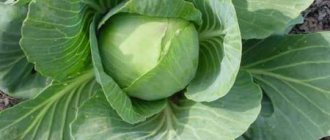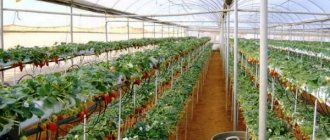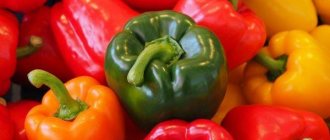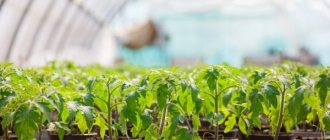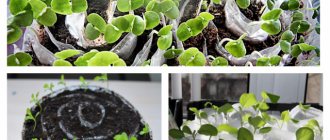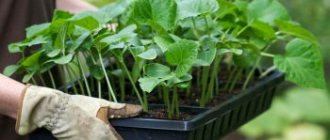Any greenhouse is a very complex system that requires not only the selection of planting material, but also compliance with microclimate conditions, which is very important for plant development and abundant fruiting. Today, a variety of methods are used to maintain proper temperature conditions. The temperature in a greenhouse can be raised or lowered using simple but extremely effective measures. It is not at all necessary to purchase expensive equipment for heating or ventilation; mulching, creating special film shelters or mini-greenhouses that are mounted above the beds are enough. In some cases, it is enough to paint the outer surface of the walls with ordinary chalk mortar.
Diagram of the automatic greenhouse ventilation system: 1 - lower transom; 2 - frame; 3 - upper transoms; 4 - flexible rod of the lower transom; 5 — flexible rod; 6 - hydraulic cylinder; 7 — brackets; 8 - blocks; 9 - door.
Why is temperature control so important for greenhouses? For active and proper growth of each individual crop, its own conditions are required. Only then do the seeds quickly germinate, begin to gain strength, enter the flowering phase and subsequent fruit set. That is why it is recommended to use sensors to determine the temperature level and take measures to control it.
What should the temperature be in the greenhouse?
The temperature must be at a certain level, but what is the best temperature? It all depends on the crops that will be grown, but there is an average value that is usually observed. The optimal level during the day is 16-25°C, at night – 4-8°C. In order for plants to develop, a gradual increase of 10°C is recommended, but we must not forget that 40°C is the limit, above it the plants will die.
It is important to monitor not only the air temperature, but also the soil temperature. Many control methods are aimed specifically at controlling the soil temperature at the time of seed germination and rooting of cuttings.
The optimal value for the soil is 14-25°C, but a decrease to 10°C leads to the fact that plants begin to starve from a lack of phosphorus.
An increase to 25-28°C leads to the roots overheating, moisture absorption becomes difficult, and the plantings begin to wither.
Classification of plants depending on temperature requirements
Crops grown in a greenhouse, depending on temperature requirements, can be divided into several groups:
- Cold-resistant - crops that are resistant to low temperatures. These include spinach, various types of cabbage: Brussels sprouts, cabbage, Savoy, kohlrabi and others. Seeds of these crops germinate best at t°+ 20-22°C, and seedlings develop if the temperature in the greenhouse is maintained at +14-15°C ± 3° depending on the weather - sunny or cloudy, at night is acceptable temperature reduction to +6-10°C.
- Moderately thermophilic - crops that develop well in a greenhouse at temperatures up to +16-17°C ± 2° correction for cloudy or sunny weather. This group includes various varieties of lettuce and onions, celery, chard, and beets.
- Heat-loving crops, the development of which requires the creation of a temperature in the greenhouse of about +20°C ± 4°, adjusted for weather. At night, it is permissible to reduce the temperature to +12°C. Representatives of this group are tomatoes, eggplants, peppers, cucumbers and other pumpkin crops; their seeds germinate better if the temperature in the greenhouse is kept at +25-28°C.
Attention! When planning to grow vegetable seedlings in a greenhouse, it is recommended to select crops with similar microclimate requirements.
Tomatoes require a temperature of about 20 degrees
Why use an automatic regulator in a greenhouse?
Temperature conditions for growing cucumbers in a greenhouse.
In order to devote most of your energy to growing crops rather than creating a microclimate, it is recommended to use automation. The costs of its purchase and installation will pay off quite quickly with a rich harvest and its quality. It is worth paying attention to the following figures:
- creating a microclimate and growing efforts takes approximately 20%;
- productivity – 80%.
Maintenance of the greenhouse premises is reduced to the highest possible level, this allows you to grow several crops at once or maintain different greenhouses. The operating principle of an automatic temperature controller is quite simple. It includes a sector body, a special inspection cover, a pusher link and a rotary valve. When the room temperature rises above 25°C, the air in the tank begins to heat up, that is, its volume increases. The valve turns and a special link quickly opens the valve. When the temperature drops, the air in the tank cools, ensuring the closure of the transom flap.
Such a regulator does not require any connection to the electrical network; it operates autonomously and does not require constant maintenance or repair. They prefer to install it for small greenhouses, in which the temperature must be at a certain level constantly.
Greenhouse controller
It is not always possible for a gardener to control all the internal parameters of a greenhouse. The owner may not be able to be present on the site 24/7, or he may simply be too lazy to get up at night and monitor the condition of the greenhouse. And as everyone knows, laziness is the engine of progress or the need to introduce the fruits of progress, because special controllers have long been produced for such purposes.
The controller is usually a small plastic box containing electronic circuit boards. The controllers are connected to input sensors that generate a signal to activate the corresponding action, and the outputs are connected to a mechanism that performs the required actions.
The actions that the controller initiates can be:
- Control of air temperature inside and outside the greenhouse;
- Control of soil temperature in the greenhouse (can be reduced);
- Opening and closing windows to the required height;
- Starting automatic watering;
- Start heating;
- Lighting control;
- Etc.
Progress does not stand still, and, accordingly, the functionality of controllers increases; regulation using relays is very convenient. Controllers can range from the simplest ones, made independently and just controlling the air temperature for organizing ventilation, to the most minicomputers with Wi-Fi. If you correctly form the microclimate in the greenhouse, the harvest will be rich and of high quality, and will also delight you for a long time.
Methods for adjusting temperature
Device and instructions for assembling an automatic greenhouse ventilation machine “Dusya-San”.
What temperature should be maintained in greenhouses? Achieving certain indicators manually is problematic. To maintain the optimal temperature at all times, you cannot do without automation. When transitioning from night to day temperatures, sudden changes should not be allowed; in many conditions it is recommended to increase/decrease the level by 3-4°C at a time. A variety of methods are used for this.
To increase the temperature level in the greenhouse by a couple of degrees, the following actions must be taken:
- At night, special film shelters are used to cover the plantings. Layers of material are fastened with fasteners in such a way as to create a so-called air cushion, which will completely isolate the plantings from the air from the room. It is with this method that the temperature can be increased by 2-3°C;
- there may not be enough film in the form of temporary shelter, so the side walls of the greenhouse can be treated with a special foam film;
- you can mount an additional low greenhouse, the frame of which will be made of wire or wicker rods. The greenhouse covering is made from solid or perforated film with a layer thickness of up to 0.5 mm. For such a greenhouse, it is important to ensure constant ventilation, but in sunny weather it should be removed, since the temperature increase can be significant, and this will lead to the death of the plantings. Ventilation is also necessary to prevent condensation from forming under the greenhouse, which is also harmful to plants;
- the soil can be mulched using spunbond or a thin layer of film, but the color of these materials should be black and not transparent. This mulching is used only for low plantings, but the difference in temperature level is small, somewhere up to 1-2°C;
- The temperature level should not be increased too much, especially on days when the sun is bright. If you do not follow this rule, burns will appear on the leaves and the fruits will become limp.
How to reduce the temperature to the required level?
Diagram of a thermal drive device for a greenhouse.
To lower the temperature in the greenhouse, the following actions must be taken:
- During construction, greenhouses cannot be made too long; it is necessary to maintain an optimal ratio between length and width. For small buildings, the following data are considered the best: width - 3 m, length - 4, 5, 6 m;
- Enough fresh air should flow through the gables, especially on very hot days when the sun is too bright. In this case, it is possible to achieve a decrease in temperature level from 10°C in the greenhouse;
- Film screens can be used to protect seedlings. You won’t be able to achieve any special results, but you can lower the temperature by 2-3°C;
- You can also use a method such as spraying the outer walls with a solution containing flour, clay, and chalk. To prepare the solution, you need to take 2 kg of chalk and 0.4 liters of milk per 10 liters of water. When it is necessary to increase the temperature in the greenhouse, the chalk is simply washed off with plain water. You should not use emulsion paints or quicklime, which make the greenhouse coating dull; it does not transmit light well;
- The temperature level in the greenhouse must be strictly maintained. Watering also affects its performance. It is recommended to do it only in the morning.
To regulate the temperature level in the greenhouse, it is necessary to use special sensors that will show all the data. Having looked at them, it will be possible to decide what measures need to be taken to create an optimal microclimate. In addition, a heating system is used to increase the level; ordinary horse manure with straw and other methods are used to initially warm the soil.
Growing on straw
If there is wheat straw that has not been treated with herbicides, it can be used as a substrate and biofuel. Compressed straw in the form of bales is placed in furrows to a depth of 20 cm.
15 days before planting, the straw is watered with hot water (40...60°C) in three doses: on the first day - 4-5 l; on the second - 3–4 l; on the third - 2-3 liters per bale. Then sprinkle on the surface of each bale:
- on the first day double superphosphate (200 g);
- on the second - ammonium nitrate (330 g), potassium sulfate (80 g), magnesium sulfate (40 g);
- on the third day - 240 g of fluff lime.
Fertilizers are washed into the bales with irrigation water.
3 days after washing in the fertilizer, the straw warms up and the temperature inside the bales reaches +35...45°C. After the temperature of the straw drops to +30°C, cucumber or tomato seedlings can be planted in it.
When growing plants on compressed straw, it is necessary to increase the rates and timing of watering, preventing the substrate from drying out.
Straw bales are a good substrate for plants; they have a good ratio between solid, liquid and gaseous phases and maintain a favorable thermal regime for the root system of plants for a long time.
The need for straw can be determined based on the dimensions of the bales: 40×50×90 cm, the weight of one bale is 20-25 kg.
- Useful articles
- Garden
- Gardener
- Heating a greenhouse: microclimate regulation
Garden themes
Garden themes
New in the section
Weed-free vegetable garden: from dream to reality Late blight: causes and methods of combating brown rot If cucumbers turn yellow: diagnosis and problem solving Yacon is a valuable plant: cultivation and care How to properly harvest carrots
2012-2019 Useful magazine Good-Tips.PRO (+18)
Optimal temperature for growing tomatoes
Examples of opening windows in a greenhouse.
To ensure an excellent tomato harvest, constant temperature control should be maintained not only during growth itself, but also during fruiting. For tomatoes, the optimal level is considered to be a temperature of 20-22°C if the day is sunny and bright. And 19-20°C is enough for cloudy weather. At night, the best temperature for tomatoes is 16-17°C.
This regime must be strictly observed until the fruiting period begins. After flowering begins and the first fruits begin to form on the branches, the temperature should be constantly maintained at 26-32°C. When it's hot, photosynthesis doesn't occur and pollen grains simply stop germinating. During flowering itself, the level should not be lowered below 14-16°C, even at night. If it gets colder, flowering will stop completely, that is, fruiting simply will not occur.
The fruiting process needs to be controlled; there may come a time when it becomes too violent. Then it needs to be stopped a little, otherwise all the plant’s strength will go into the first waves, and the rest of the fruits will have no strength or nutrition left. During this period, the temperature level should be kept at 25-26°C. This will stabilize the yield and make fruiting abundant and regular throughout the entire period. Fruit ripening should occur at a level of 16-17°C; it is simply impossible to set the temperature lower.
Why do you need thermal protection ↑
It so happened that protected ground structures were originally made precisely to maintain a microclimate inside that was suitable for seedlings, mainly to create heat. Whatever the weather outside, the crops inside should be quite comfortable. And this contributes to high yields.
The main indicator influencing the amount of heat in a greenhouse is the effectiveness of thermal protection provided by the enclosing surface. That is, the greenhouse material must be selected so that the sun's rays easily enter inside, but the heat they create is not lost. Since an ideal and transparent heat insulator has not yet been invented, heat loss to the environment is inevitable. Therefore, it is so important that adjusting the temperature in the greenhouse allows you to quickly resolve issues of heating the air or protecting against overheating.
An example of an industrial mechanical temperature controller for rooms with high humidity
In winter, greenhouse enclosures must be sealed and insulated. For these purposes, polystyrene foam and more durable polystyrene foam, foil insulation, and other synthetic materials are used. It is practiced to install a multilayer film coating with air gaps. This way the heat will be retained better, but the sun's rays will be less able to penetrate inside. But in this case this is the main source of heating. A “greenhouse effect” is created when penetrating solar energy is converted into infrared thermal energy and accumulated.
Many people recommend installing roller blinds so they can be opened during the day and closed at night to keep the heat in when it's cold. And in the summer, if it’s hot, you can use them as a temperature regulator in the greenhouse, protecting the room from overheating. Natural solar heating provides slight fluctuations in day and night temperatures. Many plants react positively to small differences (up to 4, maximum 8 °C), this even stimulates their proper development. At night and when it is cloudy outside, the indoor garden should also become cooler. If, in the absence of sun, it is too hot under the film, then the growth of green mass is provoked, and the yield and quality of the fruit are reduced.
Optimal temperature for growing cucumbers
When growing cucumbers in a greenhouse, do not forget about the temperature regime. In certain phases of growth it should be different:
- before the first shoots appear, it is necessary to keep all plantings at a temperature of 25-28°C;
- After the first shoots appear, it is necessary to remove the film from the beds. For sowing, in addition to excellent lighting, a temperature of 20-22°C is required;
- At night, seedlings must be kept at a temperature of 16-17°C (especially the first 3-5 days). Adult plants should be kept at 19-20°C at night.
When growing cucumbers, you need to make sure that there are no sudden changes. This can lead not only to diseases and poor harvests, but also to the death of all plantings. Do not allow drafts during ventilation. In order for the temperature to be optimal, it is necessary to install special sensors and regulators that will ensure a smooth change in level to the required values.
When growing any garden crops in greenhouses, it is important to maintain the temperature level. This requires the installation of automation and special regulators that will help control the microclimate. This will not only stimulate plant growth, but will also contribute to a bountiful harvest.
